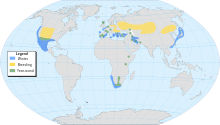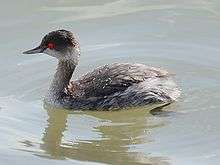Black-necked grebe
| Black-necked grebe | |
|---|---|
 | |
| Podiceps nigricollis nigricollis, adult breeding plumage | |
%2C_non-breeding_plumage.jpg) | |
| Podiceps nigricollis californicus, adult non-breeding plumage | |
| Scientific classification | |
| Kingdom: | Animalia |
| Phylum: | Chordata |
| Class: | Aves |
| Order: | Podicipediformes |
| Family: | Podicipedidae |
| Genus: | Podiceps |
| Species: | P. nigricollis |
| Binomial name | |
| Podiceps nigricollis Brehm, 1831 | |
 | |
| Range of P. nigricollis Breeding Year-round Winter | |
The black-necked grebe (Podiceps nigricollis), known in North America as the eared grebe, is a member of the grebe family of water birds. It occurs on every continent except Australia and Antarctica.
Taxonomy
There are three subspecies:[2]
- P. n. nigricollis – (Brehm, CL, 1831): nominate, is found from western Europe to western Asia (wintering to the south and west), in central and eastern Asia, and in eastern Africa
- P. n. gurneyi – (Roberts, 1919): is found in southern Africa
- P. n. californicus – (Heermann, 1854): is found from southwestern Canada through the western U.S. It winters as far south as Guatemala.
Both common names for this species refer to features visible when the bird is in its breeding plumage; in such plumage, it has an all-black neck and a spray of golden plumes on each side of its head. The name "eared grebe" was in use nearly a century before the name "black-necked grebe". The latter was first used in 1912 by Ernst Hartert, in an effort to bring the common name of the species in line with its scientific name.[3] The genus name of this species—Podiceps—comes from two Latin words: podicis, meaning "vent" or "anus" and pes meaning "foot".[4] This is a reference to the attachment point of the bird's legs—at the extreme back end of its body. The specific epithet nigricollis is Latin for "black-necked": niger means "black" and collis means "neck".[5]
Description and range

The black-necked grebe is 28–34 centimetres (11–13 in) long. The adult is unmistakable in summer, with a black head and neck and yellow ear tufts. In winter, this small grebe is white with a poorly defined black cap, which distinguishes it from the crisper-looking Slavonian grebe (horned grebe in America).
In courtship the male gives a mellow poo-ee-chk call to the female.
This species breeds in vegetated areas of freshwater lakes across Europe, Asia, Africa, northern South America and the southwest and western United States. The North American subspecies, P. n. californicus, is known as the eared grebe (or "eared diver"). These birds migrate in winter, mostly to the Pacific Coast where they range south to El Salvador on a regular basis; vagrants may occur as far as Costa Rica.[6]
Black-necked grebes of the nominate subspecies P. n. nigricollis in the cooler temperate regions of the Old World also winter further south, with many European birds moving to the Mediterranean area. The isolated southern African race, P. n. gurneyi, is sedentary. It was named by South African ornithologist and author Austin Roberts in honour of the English bankers and amateur ornithologists John Henry Gurney and John Henry Gurney Jr..
The large breeding population in County Roscommon, Ireland, discovered about 1915, fell victim to a drainage scheme in the late 1930s; at its peak there were an estimated 250-300 pairs. Breeding, in very small numbers, was suspected in Ireland in 2002, 2006, and 2011, and confirmed in 2012.
-

Eared grebe in non-breeding plumage
-

The similar horned grebe in non-breeding plumage for comparison
Behaviour
The black-necked grebe is an excellent swimmer and diver, and pursues its prey underwater, eating mostly fish as well as small crustaceans, aquatic insects and larvae. It prefers to escape danger by diving rather than flying, although it can easily rise from the water.
Like all grebes, the black-necked grebe nests on the water's edge, since its legs are set very far back and it cannot walk well. Usually two eggs are laid, and the striped young are sometimes carried on the adult's back.
The black-necked grebe is essentially flightless for most of the year (9 to 10 months), and is one of the most inefficient fliers among avifauna. Generally, it avoids flying at all costs and reserves long-distance flight exclusively for migration. However, when migrating, it will travel as much as 6,000 km (3,700 mi) to reach prosperous areas that are exploited by few other species.[7]
Footnotes
- ↑ BirdLife International (2012). "Podiceps nigricollis". IUCN Red List of Threatened Species. Version 2013.2. International Union for Conservation of Nature. Retrieved 26 November 2013.
- ↑ Ogilvie & Rose (2003), p. 69.
- ↑ Ogilvie & Rose (2003), pp. 102–103.
- ↑ Ogilvie & Rose (2003), p. 98.
- ↑ Jobling, James A (2010). The Helm Dictionary of Scientific Bird Names. London: Christopher Helm. pp. 271, 341. ISBN 978-1-4081-2501-4.
- ↑ Herrera et al. (2006)
- ↑ Jehl et al. (2003)
References
- Herrera, Néstor; Rivera, Roberto; Ibarra Portillo, Ricardo; Rodríguez, Wilfredo (2006). "Nuevos registros para la avifauna de El Salvador" [New records for the avifauna of El Salvador] (PDF). Boletín de la Sociedad Antioqueña de Ornitología (in Spanish and English). 16 (2): 1–19.
- Ogilvie, Malcolm; Rose, Chris (2003). Grebes of the World. Uxbridge, UK: Bruce Coleman. ISBN 1-872842-03-8.
- Jehl Jr., J.R.; Henry, A.E.; Ellis, H.I. (2003). Berthold, Peter; Gwinner, Eberhard; Sonnenschein, Edith, eds. Optimizing migration in a reluctant and inefficient flier: the eared grebe. Avian Migration. Springer. pp. 199–209. ISBN 978-3-540-43408-5.
External links
| Wikimedia Commons has media related to Podiceps nigricollis. |
| Wikispecies has information related to: Podiceps nigricollis |
- Ageing and sexing (PDF) by Javier Blasco-Zumeta & Gerd-Michael Heinze
- Podiceps nigricollis in the Flickr: Field Guide Birds of the World
- "Podiceps nigricollis". Avibase.

- BTO BirdFacts - Black-necked Grebe
- Eared Grebe Species Account – Cornell Lab of Ornithology
- Black-necked Grebe Species text in The Atlas of Southern African Birds.
- Eared Grebe – eNature.com
- Eared Grebe – Podiceps nigricollis – USGS Patuxent Bird Identification InfoCenter
- Watch Black-necked Grebe (Podiceps nigricollis) video clips from the BBC archive on Wildlife Finder
- "Black-necked grebe media". Internet Bird Collection.
- Eared Grebe photo gallery at VIREO (Drexel University)
- BirdLife species factsheet for Podiceps nigricollis
